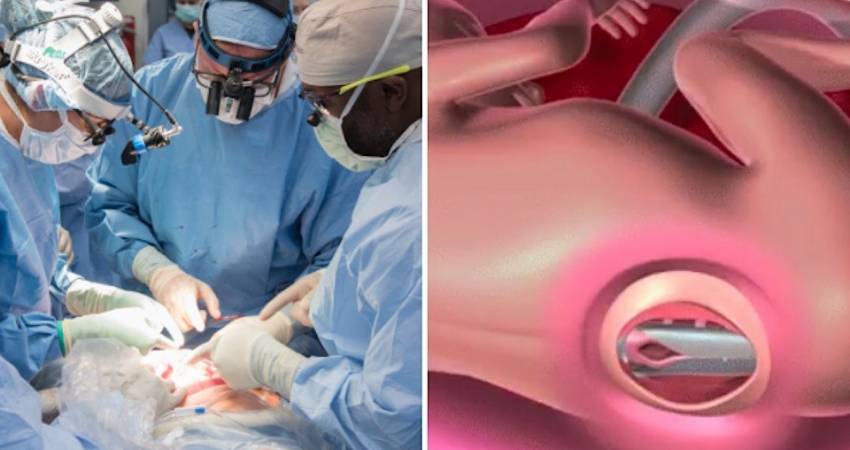
Watch: This amazing video shows Spina Bifida operation on unborn baby
A video made by Cleveland Clinic illustrating how it had successfully performed its first in utero foetal surgery to repair a spina bifida birth defect in a nearly 23-week-old foetus is now attracting significant attention on social media.
The clinic says that a team of clinicians, representing many specialties, performed the surgery in February, and the baby, a girl, was later delivered by caesarean section. Mother and daughter are doing well.

The video shows an overview of how the surgical team worked to repair the spina bifida lesion which had been observed on the baby’s spine. Surgeons carefully sew together several individual layers of tissue in order to cover the defect – all while the baby remains attached to the mother.
After the operation is complete, the womb is closed back up, and the baby continues in utero for the remainder of the pregnancy and is ultimately born by caesarean section. Although the surgery was performed in 2019, it seems to be attracting additional attention online now.
The surgical team, led by Darrell Cass, M.D., director of Fetal Surgery in Cleveland Clinic’s Fetal Center and a specialist who has performed more than 160 fetal surgeries since 2002, included Amanda Kalan, M.D., medical director of Cleveland Clinic’s Special Delivery Unit; Violette Recinos, M.D., and Kaine Onwuzulike, M.D., both pediatric neurosurgeons; Francine Erenberg, M.D., fetal cardiologist; and McCallum Hoyt, M.D. and Tara Hata, M.D., obstetric and pediatric anesthesiologists.
Spina bifida is a birth defect that is most often discovered during the routine anatomy scan typically performed when a fetus is around 18 weeks old.
The condition affects the lowest part of the spine and occurs when the neural tube does not fully close, causing the backbone that protects the spinal cord not to form as it should. This often results in damage to the spinal cord and nerves and can even lead to brain damage.
Spina bifida can affect a child’s lower leg strength and their ability to walk and run, as well as their ability to go to the bathroom and urinate adequately. According to the CDC, approximately 1,645 babies are born with spina bifida each year in the United States.
During the fetal repair surgery, a caesarean section-like incision is made and the mother’s uterus is exposed. An ultrasound is then used to locate the placenta and fetus.
The uterus is opened 4.5 cm and the back of the fetus is exposed, showing the spina bifida lesion. The surgeons then carefully suture several individual layers of tissue (myofascia, dura and skin) in order to cover the defect. After the uterus is closed back up, the fetus remains in the womb for the remainder of the pregnancy and is ultimately born by caesarean section.
“By successfully repairing the defect before birth, we’re allowing this child to have the best possible outcome and significantly improve her quality of life,” said Dr. Cass. “There are different measures of quality in determining success for fetal repairs and in this particular case, all metrics for maximum quality were achieved.”
The success of this surgery was based on two metrics – restoration of normal brain structure and the gestational age at birth.
Prior to fetal repair surgery, the back of the brain herniates down the spinal column – known as an Arnold-Chiari malformation – causing cerebrospinal fluid to back up and build pressure that can cause brain damage. Typically babies with spina bifida need shunts to decompress the built-up fluid after they are born.
When a successful fetal surgery repair is completed and the brain is examined one month later, the malformation is reversed and the back of the brain returns to a normal appearance, which was observed in this case.
The surgery was also successful by the second metric – when the baby is born. The average birth after fetal surgery repair is 34 weeks gestation. In this case, the baby was born at 36.5 weeks gestation – exceeding the average birth time by more than two weeks and giving the baby more time to develop and grow.
“Although the surgery was a success, spina bifida is never cured,” said Dr. Cass. “Moving forward, the baby will require ongoing supportive care provided by a multidisciplinary team of caregivers in our Spina Bifida Clinic, which will involve neurology, urology, orthopedics, developmental pediatrics and neurosurgery, among other specialists.”
The surgical team from Cleveland Clinic’s Fetal Center worked for more than a year to prepare for this first surgery, including making site visits to other centers, conducting simulations, and consulting with other experts in the field.
“I am honored to work with this amazing team of clinicians and to see our efforts come to fruition after preparing for so long,” said Dr. Cass, who joined Cleveland Clinic as director of Fetal Surgery in October 2017 to build its fetal surgery program after co-founding and co-directing Texas Children’s Fetal Center in Houston for 17 years. “Families in this region now have more options when it comes to making these types of decisions and we are thrilled to be able to provide the care needed for these complex cases.”
PHOTOS from the Cleveland Clinic show the skilled surgeons operating.

Darrell Cass, M.D., performs an in utero surgery to repair a spina bifida birth defect in a nearly 23-week-old fetus.



Pediatric neurosurgeons Violette Recinos, M.D. and Kaine Onwuzulike, M.D. perform repair
This article was first published in Gript and is printed here with permission
Featured
- Campaign to stop EU funding out of state abortions - tell your EU commissioner to vote NO
- Judge recuses himself from case of woman praying in censorship zones for “apparent bias”
- I’m a Celebrity star criticises “sad” UK law that aborts babies with Down Syndrome up to birth
- British actress speaks out on “serious risk” assisted suicide bill has for those with eating disorders
- Caplan’s “Tragic Hysteria of Abortion” discusses the flaws with mainstream Turnaway Study interpretations
- Backlash as Scotland report proposes legalising sex-selective abortion up to birth
- Canada hits new record as 1 in 20 deaths a result of Euthanasia
- Ben Scallan defends pro-life on TV show Dinner with the Enemy
- Influencers share the loss of their beloved unborn baby
- Dublin woman with cancer says unborn child was sent to save her
- Mother and baby doing well after surgery for mother’s cancer during pregnancy
- Josiah: Abortion Survivor
- Loving the Unborn
- Rally for Life 2025
- Don't assist Suicide 2024


























